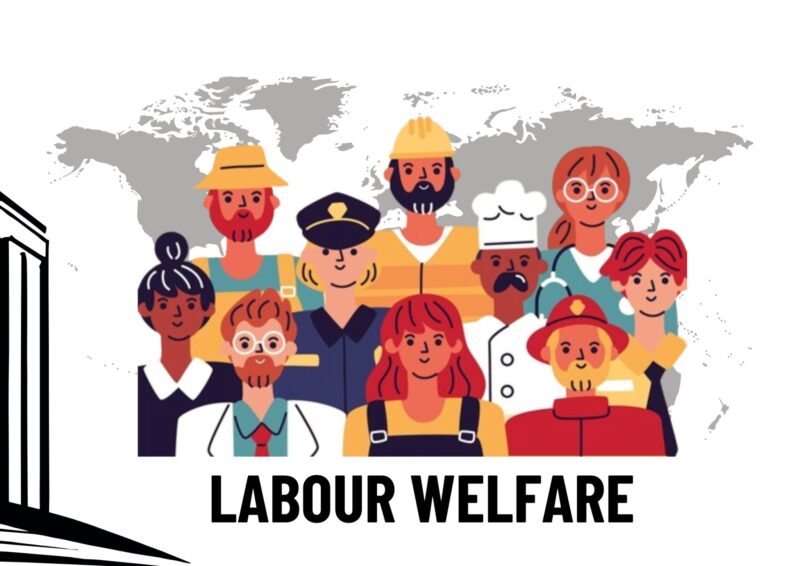Nurturing the Workforce: A Comprehensive Guide to Labour Welfare Fund in 2024
The introduction to the Labour Welfare Fund sets the stage for understanding the significance and purpose of this statutory initiative aimed at enhancing the well-being of workers. Here’s a introduction:
Introduction to Labour Welfare Fund: Nurturing the Workforce
In the dynamic landscape of employment and industrial relations, the concept of labor welfare holds paramount importance. Rooted in the belief that a satisfied and cared-for workforce is key to sustainable economic growth, the Labour Welfare Fund (LWF) emerges as a crucial instrument designed to uplift the lives of workers and their families.
Understanding the Essence of Labour Welfare:
At its core, labor welfare is a multifaceted approach that extends beyond traditional salary structures. It encompasses the holistic well-being of employees, recognizing that their prosperity is intricately linked to the overall success of an organization and, by extension, the broader community. The Labour Welfare Fund, established by various state governments, serves as a tangible manifestation of this philosophy.
Purpose and Objectives:
The primary purpose of the Labour Welfare Fund is to provide a safety net for workers, ensuring that their fundamental needs are met and that they have access to essential services. From financial assistance during emergencies to comprehensive healthcare coverage, educational support, and housing initiatives, the fund is a testament to society’s commitment to the welfare of those contributing to its economic fabric.
How does the process work?
The charity in the Labour Welfare Fund may be made annually, partial monthly or yearly. The prevalence may differ depending upon the state specific Act. Further, if the frequency is partial yearly the period of deduction shall be divided into two successional ages as per the date mentioned in the state specific Act. The employer needs to make the deduction from the payment of the hand and submit the same to the Labour Welfare Fund board in the defined form before the due date.
Here are common areas where the Labour Welfare Fund is often utilized:
- Healthcare Services:
Provision of medical facilities and healthcare services for employees and their dependents.
- Educational Assistance:
Scholarships, stipends, or financial aid for the education of workers’ children.
- Housing and Accommodation:
Subsidized housing schemes or financial assistance for housing needs.
- Social Security and Insurance:
Life insurance coverage for workers to provide financial protection to their families in case of untimely death.
- Maternity Benefits:
Maternity leave benefits, including paid leave and financial assistance for maternity-related expenses.
Changes and Adaptations in 2024: Evolving Labour Welfare Fund Dynamics
In the ever-changing landscape of employment and labor relations, 2024 brings forth a series of notable changes and adaptations to the Labour Welfare Fund (LWF). As the needs and expectations of the workforce continue to evolve, so too must the mechanisms in place to ensure their well-being. This section delves into the transformative shifts and forward-looking adaptations within the LWF framework, highlighting the initiatives and adjustments that mark this progressive era.
- Digital Integration for Seamless Transactions:
A prominent change in 2024 is the accelerated integration of digital platforms within the LWF framework. Recognizing the need for efficiency and accessibility, many states have embraced technology to streamline fund-related processes. Online platforms now facilitate easy access to information, application procedures, and real-time tracking of benefits. This digital transformation not only enhances transparency but also provides a user-friendly experience for both employers and employees.
- Customization of Benefits for a Diverse Workforce:
In response to the diverse needs of the modern workforce, LWFs are increasingly moving towards a more flexible and personalized approach to benefit distribution. Employees now have the option to tailor their benefits, choosing from a menu of offerings that align with their specific requirements. This adaptability not only acknowledges the individuality of each worker but also enhances the overall effectiveness of the fund in meeting diverse needs.
- Enhanced Health and Wellness Programs:
2024 witnesses a notable surge in the emphasis on employee health and well-being. LWFs are now allocating resources to comprehensive health and wellness programs that go beyond traditional medical coverage. Mental health support, fitness initiatives, and stress management programs are becoming integral components of the fund. This holistic approach recognizes that a healthy workforce is a more productive and resilient workforce.
- Transparent Reporting and Accountability:
In an era where transparency is paramount, LWFs are implementing measures to enhance reporting and accountability. Clear guidelines on fund utilization, regular audits, and increased communication channels contribute to a more accountable and trustworthy system. This ensures that both employers and employees have a clear understanding of how the fund operates and how it directly benefits the workforce.
Latest Amendments in Labour Welfare Fund Regulations
- Amendment Under The Andhra Pradesh Labour Welfare Fund Rules, 1988
The Government of Andhra Pradesh vide notification no. G.O.Ms.No.3, amended the penal provisions including addition of procedures on appointment of authorities and appeal for fines.
- The Tamil Nadu Labour Welfare Fund (Amendment) Act, 2021
Government of Tamil Nadu vide notification No. 455 has amended Section 15 of the Tamil Nadu Labour Welfare Fund Act, 1972. As per the amendment, the Government has increased the contribution of employees from ten rupees to fifty rupees and the contribution of employers from twenty rupees to hundred rupees.
- Amendment To The West Bengal Labour Welfare Fund Act, 1974
The Government West Bengal vide Notification No. Labr/1700/ESTT has amended the West Bengal Labour Welfare Fund Act, 1974. As per the amendment, the employer’s and employee’s contribution to the board shall be paid electronically through the designated portal (https://lwf.wblabour.gov.in/wblabour/).
FAQs (Frequently Asked Questions)
- Who is eligible for the Labour Welfare Fund benefits?
Answer: Eligibility criteria vary by state, but generally, employees in covered industries or establishments, meeting specified wage and employment conditions, are eligible for LWF benefits.
- How is the Labour Welfare Fund contribution calculated?
Answer: The contribution is calculated as a percentage of the employee’s wages, with both the employee and employer making contributions. The specific rates are determined by the state’s LWF Act.
- Can employees choose the benefits they receive from the Labour Welfare Fund?
Answer: In some modern implementations, employees may have the option to customize their benefits, choosing from a range of offerings to align with their specific needs.
- Are there any changes or adaptations in the Labour Welfare Fund in 2024?
Answer: Yes, 2024 has seen notable changes, including increased digital integration, personalized benefit options, enhanced health and wellness programs, and a focus on socially responsible investments.
Conclusion: Nurturing Progress through Labour Welfare Fund
In the intricate tapestry of employment dynamics, the Labour Welfare Fund (LWF) stands as a beacon of commitment to the well-being of the workforce. As we conclude our exploration into the essence of the LWF, its adaptations in 2024, and the myriad ways it uplifts the lives of employees, we reflect on the pivotal role it plays in fostering a harmonious and progressive work environment. Evolving with the Times:
The year 2024 marks a transformative phase for the Labour Welfare Fund. The infusion of digital technologies, customizable benefit options, and an increased focus on health and wellness programs showcase a responsiveness to the evolving needs of the modern workforce. This adaptability ensures that the LWF remains a relevant and dynamic force in promoting employee welfare.
List of Acts
| State | List of Acts |
| Maharashtra | The Mumbai Labour Welfare Fund Act, 1953 |
| Haryana | The Punjab Labour Welfare Fund Act, 1965 |
| Punjab | The Punjab Labour Welfare Fund Act, 1965 |
| Chandigarh | The Chandigarh Labour Welfare Fund Act, 1965 |
| Tamil Nadu | The Tamil Nadu Labour Welfare Fund Act, 1962 |
| Andhra Pradesh | The Andhra Pradesh Labour Welfare Fund Act, 1987 |
| Gujarat | The Mumbai Labour Welfare Fund Act, 1953 as extended to Gujarat |
| West Bengal | The West Bengal Labour Welfare Fund Act, 1974 |
| Kerala | The Kerala Labour Welfare Fund Act, 1975 |
| Delhi | The Mumbai Labour Welfare Fund Act, 1953 as extended to Delhi 2002 |
| Karnataka | The Karnataka Labour Welfare Fund Act, 1968 |
| Chhattisgarh | The Chhattisgarh Labour Welfare Fund Act, |
| Madhya Pradesh | The Madhya Pradesh Labour Welfare Fund Act, |
| Goa | The Goa Daman & Diu Labour Welfare Fund Act, 1986 |
In India the labor welfare fund is imposed at the state level. However, not all the states impose this tax; the following states impose this levy in India, details are given below: –
| State | Status | Deduction Month | Employee | Employer | Total |
| Andhra Pradesh | Yearly | December | 30 | 70 | 100 |
| Karnataka | Yearly | December | 20 | 40 | 60 |
| Tamil Nadu | Yearly | December | 10 | 20 | 30 |
| Telangana | Yearly | December | 2 | 5 | 7 |
| Kerala | Monthly | Every month | 20 | 20 | 40 |
| Haryana | Monthly | Every month | 25 | 50 | 75 |
| Punjab | Monthly | Every month | 5 | 20 | 25 |
| Chandigarh | Monthly | Every month | 2 | 4 | 6 |
| Gujarat | Half Yearly | June & December | 6 | 12 | 9 |
| Maharashtra | Half Yearly | June & December | 12 | 36 | 48 |
| West Bengal | Half Yearly | June & December | 3 | 6 | 9 |
| Odisha | Half Yearly | June & December | 20 | 40 | 60 |
| Madhya Pradesh | Half Yearly | June & December | 10 | 30 | 40 |
| Delhi | Half Yearly | June & December | 1 | 2 | 3 |
| Chhattisgarh | Half Yearly | June & December | 15 | 45 | 60 |
| Goa | Half Yearly | June & December | 60 | 180 | 240 |


